When disaster strikes, will you be prepared?
You likely already have a list of all the foods you need to grow and stockpile, as well as the emergency and first aid supplies you need, should an emergency occur. However, resin is the ingredient you should consider keeping on hand – here’s why.
Resin is the secretion from a tree that is caused by a cut or break. Trees secrete resin to seal up injuries and reduce the likelihood of infection from disease.
Most often gathered from pine trees, there are 25+ survival uses of resin you’ve got to consider.
Waterproof Shoes
Impervious to water, pine resin can be used to treat shoes to make them waterproof. Heat it to liquid form, then apply as needed.
Make a Glue
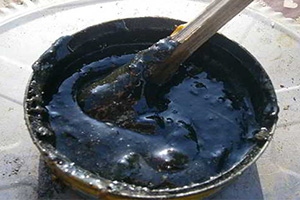 By heating resin to liquid form and adding some crumbled charcoal from your fire, you can make your own pine resin glue.
By heating resin to liquid form and adding some crumbled charcoal from your fire, you can make your own pine resin glue.
The easiest way to do this is to melt down some pine sap by placing it over a hot fire. While it’s melting, crush up some bits of charcoal into a fine powder with a stick or rock.
You will need about one part charcoal to three parts pine resin.
Once the resin has melted, you can mix in the charcoal. It will harden as it cools. To use the glue, simply heat it back up and apply it to whatever you need.
Repair Holes in Canvas
Resin can even be used to repair holes in canvas or heavy nylon.
Simply lay the material flat, heat it to liquid form, then apply using the fibrous end of a stick.
Speed Heal a Blister
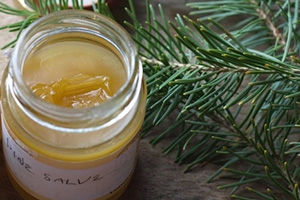 When applied to a blister, resin can not only make it heal more quickly but can also stop it from getting infected.
When applied to a blister, resin can not only make it heal more quickly but can also stop it from getting infected.
To make a salve, simply heat some resin to an oil by using a simmering double boiler.
Heat it on low until the resin melts, then strain it through a coffee filter.
Add some beeswax and return to a double boiler, heating until the mixture is fully melted and combined.
Treat a Wound
Resin can be used to prevent bacterial infection in a wound and also to help it heal. Once applied to a cut, it will stop the growth of bacteria.
Leave It in place on the wound and reapply as needed.
Related: How To Make Antiseptic Sugardine To Treat Wounds And Inflammation
DIY Fish Hooks
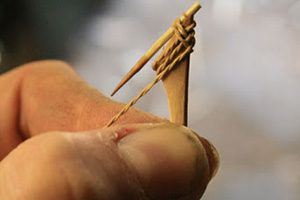 You can use the pine resin glue described above to make your own fish hooks in a pinch!
You can use the pine resin glue described above to make your own fish hooks in a pinch!
There are several different strategies you can employ for this hack, but the easiest way is to take a section of thorns from a bush. This will be the hook section of your fishhook.
You will then use a bit of cordage or thread to lash your hook together. In a true survival situation, you can even use something like dried nettle fibers.
The pine resin will hold the hook together, serving as an adhesive. You will also need a feather that will be used as the eye of the hook. You’ll strip the feather in half and attach the thorns, using the pine resin to keep everything in place.
Use Pine Resin Glue to Stop Splintering
Use the pine resin glue you made as described in the steps above to apply them to arrows and get them to harden.
You can also use these on the tips of fishing or hunting spears.
Illumination – or Pine Resin “Candle”
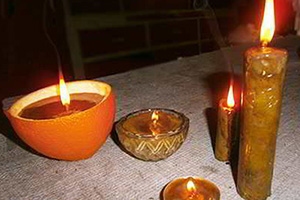 Pine resin can be used to create a lamp.
Pine resin can be used to create a lamp.
Simply fill a stone with a depression (you can also use a large shell) with resin.
You can use some dried moss or a twisted bit of cloth as a wick, which will then ignite the resin.
Heat
If you are able to find a larger container, you can follow the same steps you’d use to create the pine resin “candle” to offer a source of portable heat.
Make a Tea
Pine tea may not sound appetizing, but it is loaded with antioxidants and anti-inflammatory agents that will make you feel like a million bucks after you have a cup!
 It is incredibly easy to make. You can use the entire branch, too, to help you make the most of the heavenly aroma of the pine needles.
It is incredibly easy to make. You can use the entire branch, too, to help you make the most of the heavenly aroma of the pine needles.
Simple rinse off the branch to get rid of any dirt, then pluck the needles from the branch.
Steep them in a small mug or pot, then chop them into smaller pieces. Bring three cups of water to a simmer, then remove from the heat and add half a cup of needles.
Don’t boil the mixture, as this will break down vitamin C and lead to an unpleasant taste in your tea.
Calm a Sore Throat
Rather than reaching for the cough drops, give pine resin a try to soothe your sore throat. This is a common medicinal treatment favored by Native Americans.
Just chew on a bit of pitch to make you feel better!
Stop Bleeding
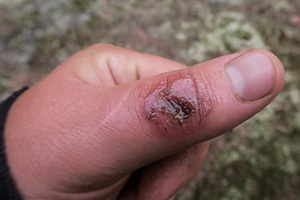 Not only is pine resin a great treatment for preventing infection and sealing up a wound to keep dirt and debris out, but it can also quickly stop bleeding.
Not only is pine resin a great treatment for preventing infection and sealing up a wound to keep dirt and debris out, but it can also quickly stop bleeding.
Just dab some pine resin on your cut and it should stop the flow.
Related: Best Natural First Aid: Stops Bleeding In 10 Seconds
Substitute for Stitches
If you have a deep cut that would normally require stitches, you may want to use pine resin to seal it up.
It will offer cross-sectional strength when combined with a bit of hair as a binding agent.
Eat it to Reduce Inflammation
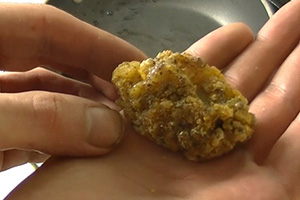 Again, pine resin won’t taste the best. However, if you make a habit of eating a nibble or two on a regular basis, it can help reduce swelling and inflammation.
Again, pine resin won’t taste the best. However, if you make a habit of eating a nibble or two on a regular basis, it can help reduce swelling and inflammation.
Some preppers swear by adding basic ingredients like honey, maple syrup, or molasses to their pine resin to help improve the flavor.
Calm an Abscess
Whether it’s an external abscess or an abscessed tooth that’s causing you misery, resin can help.
For an abscessed tooth, simply chew on a bit of resin to heal it up quickly.
Start a Fire
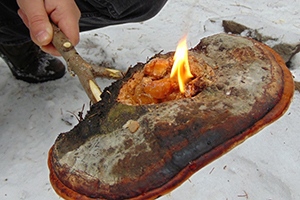 If you’ve ever burned a pine log, it will probably come as no surprise that pine resin is a great way to get things going.
If you’ve ever burned a pine log, it will probably come as no surprise that pine resin is a great way to get things going.
It is incredibly flammable and can even help you light wet wood.
Related: How to Get a Year Supply of Firewood for $10
Make a Torch
Soak a bandana in liquid pine sap, then wrap it around a stick and set it on fire.
You’ve got a portable torch that you can take with you wherever you need to go!
Patch Holes in Water Containers
Make a pine resin glue.
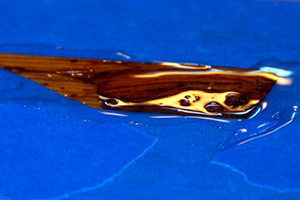
Then, use a stick to apply the glue to holes in water containers.
This is an excellent strategy for preppers who want to be more self-sufficient, as this technique will allow you to repair your things rather than running to the store to buy new ones, cutting out unnecessary expenses in the process.
Patch a Tire
In a pinch, pine resin can even be used to patch a tire to get you home. How’s that for resourceful?
Heal Rheumatoid Arthritis
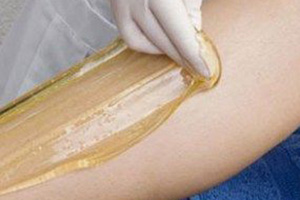 Because it is so powerful as an anti-inflammatory, pine resin can also be used to treat arthritis.
Because it is so powerful as an anti-inflammatory, pine resin can also be used to treat arthritis.
This is vital if your joints are aching and you need to keep moving!
Just apply some resin to your aching body as needed, wherever the pain is.
Treat a Rash
From poison ivy to burdock, there are all kinds of plants out there that can really make you itch!
Consider using pine resin to treat a rash – it’s far better than the store-bought alternatives
Heal a Stomach Ulcer
 A liquid pine resin (heated up and combined with water) will create a tonic that Native Americans once used to treat stomach ulcers.
A liquid pine resin (heated up and combined with water) will create a tonic that Native Americans once used to treat stomach ulcers.
Related: Lost Native American Survival Skills
It can also be used to calm sore throats and to treat symptoms of the common cold.
Extract a Stinger
If you’ve been stung by a bee or wasp, you can put some over the inflamed area and allow it to harden.
When you remove the resin, the stinger should come right out with it.
Make a Chewing Gum
 While this doesn’t seem like a survival use of pine resin at first glance, the reality is that a pine chewing gum can actually provide a valuable source of nutrients that can serve as a placeholder until you can get to your next mealtime. Just combine a bit of honey and beeswax for an edible mixture.
While this doesn’t seem like a survival use of pine resin at first glance, the reality is that a pine chewing gum can actually provide a valuable source of nutrients that can serve as a placeholder until you can get to your next mealtime. Just combine a bit of honey and beeswax for an edible mixture.
Remove a Sliver
Slivers aren’t just annoying – they can be dangerous and even deadly if they get infected.
Soften some pine resin and form it over the embedded sliver. Let it harden, then pull it away.
Find Your Way
One more unique use of pine resin is that you can use it to help mark your way when you’re out in the woods.
Leaving large globs of pine resin behind you as a “trail of breadcrumbs,” ideally on trees or on other landmarks, will help you navigate so you don’t end up walking in circles.
You can mix in charcoal or other ingredients to help it stand out more brightly in the wilderness.
Pine resin might not seem like anything but a sticky, aromatic mess.
However, it offers plenty of benefits to the average prepper – many of which you may not have yet considered.
Try out these tips and you’ll be prepared for whatever sticky situation life happens to throw at you!
You may also like:
 40 Bizarre Home Remedies Our Grandparents Taught Us That Actually Work
40 Bizarre Home Remedies Our Grandparents Taught Us That Actually Work
How to Make Bark Bread from a Tree that Grows on Almost Every Street in America (Video)

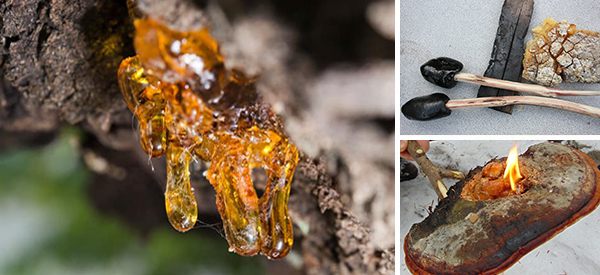














What’s the best way to harvest pine resin?
Thank you. Didn’t know any of that.
My favorite way to store the resin glue is to roll a nice dollop onto the end of a small stick and allow it to dry. This way, you can use it by simply putting the end in a fire, or even a candle, and having the outermost layer warm up. You can then apply it just like a glue stick, or use a smaller stick as a pen for finer detail work.
This is great we never knew these things about pine. Actually all your articles are fantastic.
Resin from the sweet gum tree has many of the same uses, it’s a common southeastern tree, witch hazel family.
White Pine in the North East has plenty of free-flowing “resin”.
Research White pine Blister Rust for some interesting supplemental reading.
Spruce Gum, although never a big seller, was available into the 70s.
chip: Interesting read. Thanks for the reference.
I guess I won’t be planting a white pine in my back yard as the article indicates they grow to 100 feet tall and 35 feet in diameter. A little large for my suburban SoCal microscopic lot. I will have to stick to the tar seeps which are common in this county. In one area occasionally the road has to be scraped to remove the seepage that has encroached upon it.
Glue or any other adhesive has two qualities: adhesion and cohesion. Adhesion is how well it sticks to surfaces and cohesion is how strong it is within itself. Improve adhesion with proper surface preparation. Improve cohesion by adding fibers to the resin ( plant, hair, feathers, fiberglass etc.). Disgruntled citizens would show their ire by coating local politicians with hot tar and then rolling them in feathers. The feathers weren’t to make them look like a chicken but to reinforce the tar and make it harder to pull off.
The tar used was pine tar, made from pine resin, it liquefies at a much lower temperature than oil based tar. So there are actually 26 uses for resin.
How could we get better at survival and living better without you, Claude ?? Thank you for all the knowledge you give us…
Bitumen is frequently referred to as tar. In its crudest form it is natural seepage that is semi-liquid. It can be applied to the body without being heated. Western Pennsylvania where tarring and feathering of revenue agents reached its peak during the Whiskey Rebellion probably at that time was home to open tar pits. Such tar pits can be seen today at the La Brea Tar Pits where many pre-historic and modern animals were trapped in the viscous substance and preserved in the “tar”.
We also have tar seeps here in this county from the oil that still remains underground but which can’t be used to provide fuel for the numerous SUVs and huge pick-up truck that clog the streets and highways of the PDRK. It is physically able to be recovered but the political climate of this schizophrenic state plus the innumerable rules and regulations covering its pumping make the recovery uneconomical while gasoline at the pump remains the highest in the country There is even a point called Coal Oil Point north of us due to the continuous natural oil seeps in the ocean releasing crude that cover the beaches in that locale.
It wasn’t necessarily hot refined tar which only becomes liquid at about 100°C which is 212°F. A substance that hot would cause death without quick, 20th century medical treatment.
Viscous molasses was used in one instance of “tarring” and feathering a woman in Oklahoma in the 19th century.
Wikipedia states that tarring and feathering was rarely fatal which leads me to believe that it wasn’t hot tar that was smeared on the subject of T&F but some other viscous substance resembling tar that would retain the feathers or straw which apparently was sometimes used.
Once again this site moved me to research a topic which I doubt I would have researched without the spur of the article.
Quite a few pine tar soap products for both body and hair readily available on the market today online and at specialty shops.
Ichthammol ointment which is a drawing salve is made from petroleum. It looks like the stuff I smear on my roof to waterproof it and smells like I am standing by a tar seep here in the county. I have used it for decades to draw infections on my skin.
Interesting. I just read the label for the first time in decades. It says it contains petrolatum, lanolin and mineral oil. My dictionary defines petrolatum as petroleum jelly. Ichthammol is a far cry from Vasoline which is also petroleum jelly. Ichthammol looks and smells like it was just dug out of a tar pit and stuffed in a tube.
I believe the local Chumash Indians used the tar from tar seeps for a multitude of uses from waterproofing their reed canoes to healing skin lesions and perhaps even more serious wounds. In pre-antibiotic days many substances were used to ameliorate infections as bacterial infections were a significant causative of the loss of life and limb.
My curiosity got aroused and I explored what the internet had to say about ichthammol ointment. Apparently it is still in common use in veterinary circles to treat various ailments of animals.
Wikipedia has an interesting article about its uses. They recommend against using Chinese ichthammol ointment as it does not meet the standards of neither U.S. nor European ichthammol.
Wikipedia did have this to say about it: “According to the “list of preferred Specials” by the British Association of Dermatologists (BAD) Ichthammol can be used in dermatology prescribing to treat acutely inflamed atopic eczema, among others.”
I have always used it as a drawing salve but I see that it can treat some types of eczema which is an interesting bit of information to have.
A little off topic but as long as we are discussing tar . . .
Ichthammol apparently is sulfated bitumen. When our dog had a horrendous case of mange, the doctor (no vets around for miles) recommended covering him with flowers of sulfur and lard. I forget the exact formula. My brother also painted the poor suffering animal with paint thinner which had white paint dissolved in it. I am not sure which cured the mange but shortly after receiving both “treatments” the mange started to disappear. The doc also recommended a tablespoon full of cod liver oil with every meal. Now that, the dog really liked. Between the three treatments the dog always had the richest, thickest coat of fur of any dog we ever had.
Moral of the parable: I am not sure which to recommend if you have a case of the mange. Personally, I would stick with flowers of sulfur and lard and a tablespoon full of cod liver oil (can you still buy that stuff?) with each meal. I have serious reservations with bathing in paint thinner with white paint (which at that time contained white lead) as a skin emolument.
Interesting article. Dad sometimes used pItch as a hot glue. When I’d find it in the woods I’d chewed it like gum, heat it to pull a splinter, or take it to dad. I have burned it just to enjoy the scent. Warm but not burning hot it was healing to somewhat minor injuries involving broken skin and cuts. Dad sa I d he l earned to b use it from his parents as a kid. He didn’t collect it in Eastern Kansas but they traded with folks traveling through to head toward Oregon.
By the way LCC the La Brea Tar pits were interesting. Saw them and the museum as a kid.
You will be pleased to know that one can purchase real cod liver oil from Walmart. It is $22 and change for 16 ounces which I am sure is quite a bit more than my mother paid for the stuff we gave the dog, although one purchaser who buys it for their lab highly endorsed it and confirmed that dog really liked it.
Another evaluator is taking it for a foot ulcer that has not responded to typical medical treatment?????
There was nothing that could really start your day off right like a tablespoon full of cod liver oil before breakfast. Guaranteed to give you fish breath all day long and a nauseous after taste ever time you burped which seemed to have its frequency enhanced by the cod liver oil before breakfast.
Ahh, the fond memories of growing up in the 40s. M wife also had to take cod liver oil at school in Japan during the war. They got a big capsule of it, didn’t have to mainline it right out of the bottle. She also was not fond of the after taste which apparently was not eliminated by capsule form.
They lined all the students up and the teacher handed out the capsule and made sure each and every student gulped it down.
Cod liver oil capsules are available from several sources and apparently are the preferred method for consuming cod liver oil these days. I am not sure a horse pill of cod liver oil is preferable to mainlining it off a tablespoon straight from the bottle. That’s sort of like “Do you want to be shot or hung?”
Some folks are allergic to resin, especially pine resin. My sister unfortunately is one of them. She had a bad reaction to a Johnson and Johnson’s bandaid that used resin to make the adhesive. Like anything else, before you stock up, make sure it works well for you.
Can we uses any other kind of tree resin beside of pine tree resin? Because not all of the area have pine trees.